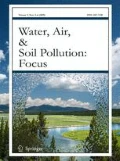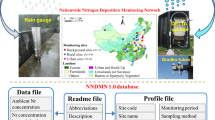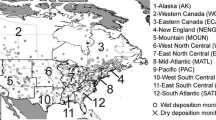Abstract
Measurements of the concentrations of nitrogen compounds in air and precipitation in the UK have been made since the mid-19th century, but no networks operating to common protocols and having traceable analytical procedures were established until the 1950s. From 1986 onwards, a high-quality network of sampling stations for precipitation chemistry was established across the UK. In the following decade, monitoring networks provided measurement of NO2, NH3, HNO3 and a satisfactory understanding of the dry deposition process for these gases allowed dry deposition to be quantified. Maps of N deposition for oxidized and reduced compounds at a spatial scale of 5 km × 5 km are available from 1986 to 2000. Between 1950 and 1985, the more limited measurements, beginning with those of the European Air Chemistry Network (EACN) provide a reasonable basis to estimate wet deposition of NO−3−N and NH+4−N. For the first half of the century, estimates of deposition were scaled with emissions assuming a constant relationship between emission and deposition for each of the components of the wet and dry deposition budget at the country scale. Emissions of oxidized N, which dominated total nitrogen emissions throughout the century, increased from 312 kt N annually in 1900 to a peak of 787 kt for the decade 1980–1990 and then declined to 460 kt in 2000. Emissions of reduced N, largely from coal combustion were about 168 kt N in 1900, increasing to a peak of 263 kt N in 2000 and by now dominated by agricultural sources. Reduced N dominated the deposition budget at the country scale, increasing from 163 kt N in 1900 to 211 kt N in 2000, while deposition of oxidized N was 66 kt N in 1900 and 191 kt N in 2000. Over the century, 68 Mt (Tg) of fixed N was emitted within the UK, 78% as NO x , while 29 Mt of nitrogen was deposited (43% of emissions), equivalent to 1.2 t N ha−1, on average, with 60% in the reduced form. Deposition to semi-natural ecosystems is approximately 15 Tg N, equivalent to between 1 and 5 t N ha−1, over the century and appears to be accumulating in soil. The N deposition over the century is similar in magnitude to the total soil N inventory in surface horizons.
Similar content being viewed by others
References
Ashworth, W. and Pegg, M.: 1986, The History of the British Coal Industry. Vol. 5: 1946–1982: The Nationalized Industry, Clarendon, Oxford, 710 pp.
Asman, W. A. H., Drukker, B. and Janssen, A. J.: 1988, ‘Modelled historical concentrations and depositions of ammonia and ammonium in Europe’, Atmos. Environ. 22, 725–735.
Battye, R., Battye, W., Overcash, C. and Fudge, S.: 1994, Development and Selection of Ammonia Emission Factors, US Environmental Protection Agency, 111 pp.
Bauer, C. and Andren, A.: 1985, ‘Emissions of vapour-phase fluorine and ammonia from the Columbia coal-fired power plant’, Environ. Sci. Technol. 19, 1099–1103.
Church, R. A., Hall, A. and Kanefsky, J.: 1986, The History of British Coal Industry. Vol. 3: 1830–1913: Victorian Pre-Eminence, Clarendon, Oxford, 831 pp.
Court, W. H. B.: 1951, ‘History of Second World War: Coal’, in W. Hancock (ed.), History of Second World War: Coal, HMSO, Longmans, Green & Co., United Kingdom Civil Series, London.
Cowling, E., Galloway, J. N., Furiness, C., Barber, M., Bresser, T., Cassman, K., Erisman, J.-W., Haeuber, R., Howarth, R., Melillo, J., Moomaw, W., Mosier, A., Sanders, K., Seitzinger, S., Smeulders, S., Socolow, R., Walters, D., West, F. and Zhu, Z.: 2002, ‘Optimising nitrogen management in food and energy production and environmental protection: Summary statement from the Second International Nitrogen Conference’, in J. N. Galloway, E. Cowling, J.-W. Erisman, J. Wisniewski and C. Jordan (eds.), Optimizing Nitrogen Management in Food and Energy Production and Environmental Protection, A. A. Balkema Publishers and The Scientific World.
Crowther, C. and Ruston, A. R.: 1913, ‘The nature, distribution and effect upon vegetation of atmospheric impurities in and near an industrial town’, J. Agric. Sci. Camb. 4, 25–55.
Devenish, M.: 1986, The United Kingdom Precipitation Monitoring Networks. LR584(AP), Warren Spring Laboratory.
Dore, A. J., Choularton, T. W. and Fowler, D.: 1992, ‘An improved wet deposition map of the United-Kingdom incorporating the seeder feeder effect over mountainous terrain’, Atmos. Environ. Part A Gen. Topics 26, 1375–1381.
Dragosits, U., Sutton, M. A., Place, C. J. and Bayley, A. A.: 1998, ‘Modelling the spatial distribution of agricultural ammonia emissions in the UK’, Environ. Pollut. 102, 195–203.
Eriksson, E.: 1952, ‘Composition of atmospheric precipitation. A. Nitrogen compounds.’ Tellus 4, 215–232, 296–303.
Erisman, J.-W.: 2000, De Vliegende Geest. Ammoniak uit de Landbouw en de Gevolgen voor de Natuur, BetaText, Bergen, The Netherlands, 271 pp.
Galloway, J. N.: 1998, ‘The global nitrogen cycle: Changes and consequences’, in K. W. Van der Hoek, J.-W. Erisman, S. Smeulders, J. R. Wisniewski and J. Wisniewski (eds.), First International Nitrogen Conference, Noordwijkerhout, The Netherlands, 23–27 March 1998, Elsevier Science.
Geadah, M.-L.: 1985, National Inventory of Natural and Anthropogenic Sources and Emissions of Ammonia (1980). Report Eps 5/Ic/1, Environment Canada, 35 pp.
Goodwin, J., Salway, A. G., Eggleston, H. S., Murrels, T. P. and Berry, J. E.: 2001, UK Emissions of Air Pollutants 1970–1999, Department for Environment, Food and Rural Affairs (DEFRA).
Goodwin, J., Salway, A., Dore, C., Murrels, T., Passant, N., King, K., Coleman, P., Hobson, M., Pye, S., Waterson, J., Haigh, K. and Conolly, C.: 2002, UK Emissions of Air Pollutants 1970–2000, Department for Environment, Food and Rural Affairs (DEFRA), 158 pp.
Goulding, K. W. T., Bailey, N. J., Bradbury, N. J., Hargreaves, P., Howe, M., Murphy, D. V., Poulton, P. R. and Willison, T. W.: 1998, ‘Nitrogen deposition and its contribution to nitrogen cycling and associated soil processes’, New Phytol. 139, 49–58.
GSS: 1973, Agricultural Statistics United Kingdom 1969–1971, Government Statistical Service (GSS).
GSS: 1996, The Digest of Agricultural Census Statistics. United Kingdom 1995, Government Statistical Service (GSS).
Jenkinson, D. S.: 1982, ‘The nitrogen-cycle in long-term field experiments’, Phil. Trans. R. Soc. Lond. Ser. B Biol. Sci. 296, 563–571.
Lawes, J. B. and Gilbert, J. H.: 1854, ‘On the amount of, and methods of estimating ammonia and nitric acid in rainwater’, Br. Assoc. Rep. 24, 70–71.
Lee, D. and Dollard, G.: 1994, ‘Uncertainties in current estimates of emissions of ammonia in the United Kingdom’, Environ. Pollut. 86, 267–277.
Misselbrook, T. H., Van der Weerden, T. J., Pain, B. F., Jarvis, S. C., Chambers, B. J., Smith, K. A., Phillips, V. R. and Demmers, T. G. M.: 2000, ‘Ammonia emission factors for UK agriculture’, Atmos. Environ. 34, 871–880.
NationalStatistics: 2001, Population of the UK (1801–2026): Social Trends, http://www. statistics. gov. uk/StatBase/.
NationalStatistics: 2003, Coal Consumption Statistics, http://www. statistics. gov. uk/.
NEGTAP: 2001, Transboundary Air Pollution: Acidification, Eutrophication and Ground-Level Ozone in the UK, Report of the National Expert Group on Transboundary Air Pollution (NEGTAP) for the UK Department for Environment, Food and Rural Affairs, Scottish Executive, the National Assembly for Wales/Cynulliad Cenedlaethol Cymru and the Department of the Environment for Northern Ireland, CEH-Edinburgh, 314 pp.
PEP: 1936, Report on British Coal Industry: A Survey of the Current Problems, Political and Economic Planning (PEP).
Pitcairn, C. E. R., Leith, I. D., Sheppard, L. J., Sutton, M. A., Fowler, D., Munro, R. C., Tang, S. and Wilson, D.: 1998, ‘The relationship between nitrogen deposition, species composition and foliar nitrogen concentrations in woodland flora in the vicinity of livestock farms’, Environ. Pollut. 102, 41–48.
RGAR: 1983, Acid Deposition in the United Kingdom by Review Group on Acid Rain, Warren Spring Laboratory, Stevenage, 72 pp.
RGAR: 1987, United Kingdom Review Group on Acid Rain: Acid Deposition in the United Kingdom 1981–1985, Department of Environment, 104 pp.
Russel, E. J. and Richards, E. H.: 1919, ‘The amount and composition of rain falling at Rothamsted.’ J. Agric. Sci. Camb. 9, 309–337.
Smith, R. A.: 1872, Air and Rain: The Beginnings of a Chemical Climatology, Longmans, Green and Co., London, 600 pp.
Smith, R. I., Fowler, D., Sutton, M. A., Flechard, C. and Coyle, M.: 2000, ‘Regional estimation of pollutant gas dry deposition in the UK: Model description, sensitivity analyses and outputs’, Atmos. Environ. 34, 3757–3777.
Stevenson, C. M.: 1986, ‘An analysis of the chemical composition of rainwater and air over the British Isles and Eire for the years 1959–1964’, Quart. J. R. Meteor. Soc. 94, 57–70.
Sutton, M. A., Pitcairn, C. E. R. and Fowler, D.: 1993, ‘The exchange of ammonia between the atmosphere and plant communities’, Adv. Ecol. Res. 24, 301–393.
Sutton, M. A., Dragosits, U., Tang, Y. S. and Fowler, D.: 2000, ‘Ammonia emissions from non-agricultural sources in the UK’, Atmos. Environ. 34, 855–869.
Sutton, M. A., Tang, Y. S., Dragosits, U., Fournier, N., Dore, A. J., Smith, R. I., Weston, K. J. and Fowler, D.: 2001, ‘A spatial analysis of atmospheric ammonia and ammonium in the UK’, in J. N. Galloway, E. Cowling, J.-W. Erisman, J. Wisniewski and C. Jordan (eds.), Optimizing Nitrogen Management in Food and Energy Production and Environmental Protection, A. A. Balkema Publishers and The Scientific World.
Townsend, A. R., Howarth, R. W., Bazzaz, F. A., Booth, M. S., Cleveland, C. C., Collinge, S. K., Dobson, A. P., Espstein, P. R., Holland, E. A., Keeney, D. R., Mallin, M. A., Rogers, C. A., Wayne, P. and Wolfe, A. H.: 2003, ‘Human health effects of a changing global nitrogen cycle’, Front. Ecol. Environ. 1, 240–246.
Warn, T. E., Zelmanowitz, S. and Saeger, M.: 1990, Development and Selection of Ammonia Emission Factors for the 1986 Napap Emissions Inventory, US Environmental Protection Agency, 55 pp.
Webb, J.: 2001, ‘Estimating the potential for ammonia emissions from livestock excreta and manure’, Environ. Pollut. 111, 395–406.
Author information
Authors and Affiliations
Corresponding author
Rights and permissions
About this article
Cite this article
Fowler, D., O’Donoghue, M., Muller, J.B.A. et al. A Chronology of Nitrogen Deposition in the UK Between 1900 and 2000. Water Air Soil Pollut: Focus 4, 9–23 (2004). https://doi.org/10.1007/s11267-004-3009-1
Issue Date:
DOI: https://doi.org/10.1007/s11267-004-3009-1




